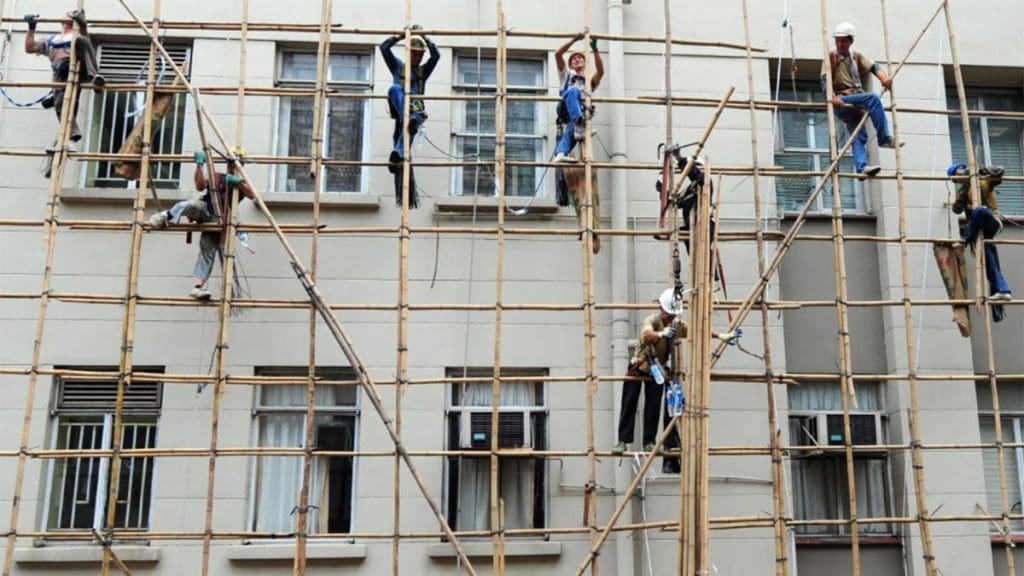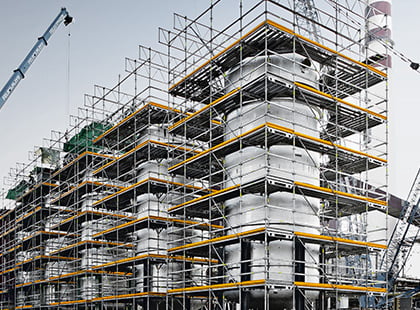Dependable Domestic Scaffolding for Homeowners in Need of Safe Renovations
The Perks of Scaffolding for Safety and Effectiveness in Building Projects
Scaffolding is a crucial element in the world of building and construction, substantially contributing to both safety and security and functional effectiveness. The impact of scaffolding extends past fundamental safety actions; its tactical execution can transform project timelines and results (Scaffolding).
Boosted Worker Security

Boosted employee safety is a paramount concern in the building industry, where the risks connected with falls and crashes can have alarming effects. Efficient scaffolding systems play a vital function in reducing these hazards by providing secure systems for workers at elevated heights. By making certain that scaffolding is effectively set up and preserved, building companies can significantly lower the chance of drops, which are amongst the leading sources of workplace injuries and casualties.
Additionally, scaffolding enhances safety and security with its design attributes. Guardrails, toe boards, and non-slip surfaces add to a safe working setting, lessening the risk of crashes. Furthermore, scaffolding allows employees to accessibility hard-to-reach locations without the need for makeshift remedies, which can jeopardize safety and security criteria.
Training employees on the appropriate usage of scaffolding is just as important. Ensuring that workers are well-informed about lots capabilities, assembly treatments, and safety protocols better boosts the performance of scaffolding in protecting against mishaps. In verdict, including durable scaffolding systems within building projects not only enhances employee security yet also advertises a culture of security that benefits the entire workforce while enhancing general efficiency.
Improved Accessibility and Wheelchair

Moreover, scaffolding enables the hassle-free transport of materials and devices, minimizing downtime connected with moving devices. Workers can effectively access numerous areas of a job, which is especially crucial in intricate builds where upright and horizontal motion is constant - Scaffolding. This access not just streamlines procedures however additionally makes it possible for groups to respond quickly to altering job demands
Furthermore, scaffolding can be customized to accommodate specific site conditions, boosting mobility in irregular or tight areas. This flexibility ensures that building activities can proceed smoothly, despite the challenges provided by the atmosphere. By promoting better accessibility and movement, scaffolding plays an important function in sustaining building staffs and maximizing the general efficiency of building projects.
Enhanced Task Performance
In building, task effectiveness is considerably affected by the effective usage of scaffolding systems. By providing a secure and protected system for workers, scaffolding decreases downtime and speeds up the pace of building tasks. With enhanced access to elevated job areas, groups can finish tasks more swiftly, reducing the total project timeline.
The modular nature of modern-day scaffolding enables for quick assembly and disassembly, find out making it possible for swift shifts in between different stages of a project. This flexibility not just boosts workflow however additionally adds to better sychronisation amongst various professions, as multiple teams can function at the same time on various sections of a framework.
In addition, scaffolding guarantees that employees are positioned correctly to do their jobs without scaffolding guidelines unneeded stress or threat of injury, therefore reducing the possibility of mishaps that can cause pricey hold-ups. Boosted precaution installed in scaffolding systems, such as guardrails and toe boards, further assistance reliable procedures by keeping employee concentrate on the job handy rather than security issues.

Versatility for Various Tasks
Scaffolding systems stand out for their versatility across a vast array of building jobs, qualified of conference details website needs and tasks. Their modular layout permits fast changes to fit various structure kinds, from property to commercial structures, making certain that workers have secure accessibility at different heights and angles.
These systems can be customized for diverse applications, such as façade job, indoor remodellings, or heavy-duty commercial projects. Lightweight aluminum scaffolds are perfect for indoor work, while robust steel frameworks supply the needed support for massive building. The flexibility of scaffolding expands to its ability to be configured for both irreversible and short-lived frameworks, permitting professionals to effectively prepare and perform their jobs.
In addition, scaffolding can be used in tough settings, consisting of city setups where room is minimal or on irregular surface where typical access services are unwise. This versatility reduces the requirement for multiple access solutions, decreasing expenses and job timelines. By fitting a selection of jobs and problems, scaffolding boosts the total efficiency and performance of construction efforts, showing to be an important possession in you can find out more the structure market.
Conformity With Security Specifications
Exactly how can construction tasks guarantee the safety and security of workers while keeping efficiency? Governing frameworks, such as OSHA in the United States, supply guidelines that regulate the usage of scaffolding, making sure that it meets strict safety and security requirements.
Proper scaffolding design and setup play an important duty in conformity. Educating employees on secure scaffold usage and the value of conformity with safety and security criteria better enhances a society of security on-site.
Furthermore, paperwork and record-keeping pertaining to security examinations and employee training are essential. These practices not only demonstrate compliance but also give liability and transparency. Ultimately, by focusing on adherence to safety and security requirements, construction tasks can promote a much safer work setting, consequently enhancing productivity and performance without jeopardizing worker safety and security.
Final Thought
To conclude, scaffolding acts as an essential element in building projects, significantly boosting security and efficiency. Its layout functions, consisting of guardrails and non-slip surface areas, contribute to a more secure working atmosphere while facilitating better accessibility and wheelchair for employees. The modular nature of scaffolding promotes quick setting up, hence boosting overall task effectiveness. In addition, adherence to safety criteria underscores the relevance of scaffolding in accomplishing effective job outcomes, making it essential in the construction market.
Scaffolding is an important component in the realm of construction, considerably contributing to both security and operational efficiency. The impact of scaffolding extends beyond standard safety and security actions; its calculated execution can change job timelines and results. In final thought, integrating robust scaffolding systems within building projects not just boosts employee security however also promotes a society of safety and security that profits the entire labor force while boosting general productivity.
In verdict, scaffolding offers as an essential part in structure tasks, significantly enhancing safety and efficiency. Adherence to safety and security criteria highlights the value of scaffolding in achieving effective task outcomes, making it essential in the construction industry.